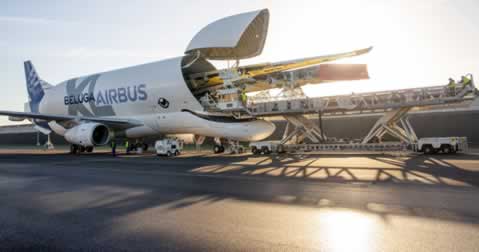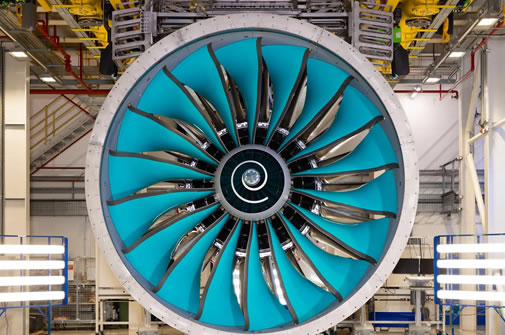空客飞机|如何制作飞机翅膀,探索设计和生产的新方法

在上一集中,我们学习了翅膀是如何工作的。但是空客是如何制造它们的呢?我们的明日之翼研究项目正在研究技术和工业系统,这些技术和工业系统可以帮助将新型低碳飞机送入天空。但首先,让我们看看今天的翅膀是如何制造的。
当然,是空客热情的组装工人将我们的机翼固定在一起。我们正在探索大约100项新技术来帮助他们,并推进我们设计和制造机翼的方式。这是我们正在进行的最大的研究项目,叫做明日之翼。
明日之翼的目标是使一系列颠覆性的方法变得成熟,这些方法可以帮助一种新的低碳飞机投入使用。有些甚至可能适用于目前的空客平台。
但首先,今天。空客是如何生产承载全球一半乘客的机翼的?
A321机翼正在制造中
把拼图拼在一起
在空中客车公司,组装和装备机翼有点像一个谜题。
以A350为例。与所有空客商用飞机项目一样,机翼的复合材料盖和其他部件(如梁和肋)是在多个空客工厂和供应链中制造的。然后操作员在我们位于英国布劳顿的工厂组装机翼。
A321机翼正在生产中(16架中的8架)
每架完成的A350机翼由BelugaXL航空运输公司运送到图卢兹,使用50%的可持续航空燃料(SAF),在最后组装时连接到中央翼盒和机身。
在完成这个生产难题之前,需要做很多事情。这个过程从上游的总体飞机设计开始。这决定了机翼的形状和特性,包括飞行控制和高升力系统。
然后开始所谓的“协同设计”阶段。机翼的结构设计与生产它所需的工业系统同时成熟。
更长,更瘦,更轻
未来,机翼将以更高的自动化水平生产。使用“为制造而设计”的流程,空客工程师将确定人工和自动化组装之间的最佳平衡,确保机翼在第一次、每次都以合适的成本生产出来。
下一代的机翼将更长、更瘦、更轻。当这些特性结合在一起时,可以帮助飞机使用更少的燃料获得升力,从而产生更少的二氧化碳排放。
机翼设计的这种变化必须与机翼生产的变化相适应。空中客车公司的工业系统需要装备起来,以经济有效的方式在体积和速度上生产这种轻型机翼。这种转变需要彻底的反思,而这正是《明日之翼》的切入点。
近距离接触明日之翼的一个演示机翼
描述:近距离和个人与明日之翼示威者之一的翅膀。
其目的不仅是准备下一代飞机所需的技术;还有员工、供应链、工业系统,以及公司的实体和数字能力。
所有人将共同努力,带来快速扩大生产所需的灵活性,同时考虑到对每天制造机翼的操作员的影响。
A321机翼正在加工(3)
更短的生产周期
明日之翼将引领空客进入工业能力的新时代,作为将效率和人体工程学改进结合在一起的新制造和自动化技术的测试平台。
例如,生产中可以引入多产品移动脉冲线,类似于汽车设备。这将使空客能够同时生产机翼的多个部件,并缩短生产周期,加快组装速度。例如,钻井自动化不仅缩短了交货时间;它解放了熟练的操作员,让他们从事附加值更高的任务。
空客也在使用数字建模来为未来机翼工厂的设计提供信息,充分利用这些新技术来优化生产时间。这种被称为“数字双胞胎”的数字化运营模型,可以帮助空客评估每个装配过程在最有效地利用材料、减少浪费和碳排放方面的影响。
下一集我们将详细介绍“明日之翼”是什么样子,以及空中客车公司是如何从大自然中汲取灵感来帮助完成繁重的任务的。请继续关注!
演示的黎明
在英国布劳顿的先进制造研究中心(AMRC)组装,三个全尺寸机翼演示将用于评估下一代机翼的不同方面。
这些示范飞机全部由轻质复合材料制成,是与全球40家合作伙伴合作生产的,其总体目标是找出任何可能阻碍这些技术在未来几代飞机上应用的瓶颈。
三个全尺寸的演示器分别是:
静态机翼演示器-用于测试新设计和材料的结构能力。
In the last episode, we looked at how wings work. But how does Airbus make them? Our Wing of Tomorrow research programme is examining the technologies and industrial systems that could help lift a new, low-carbon aircraft into the skies. But first, let’s take a look at how wings are manufactured today.
Of course, it’s Airbus’ passionate assembly workers who bolt our wings together. We’re exploring some 100 new technologies to assist them, and advance the way we design and manufacture wings. It’s our largest ongoing research project, and it’s called Wing of Tomorrow.
Wing of Tomorrow aims to mature a selection of disruptive approaches that could help bring a new, low-carbon aircraft into service. Some may even be applicable to current Airbus platforms.
But first, today. How does Airbus produce the wings that carry half of the world’s passengers?
A321 wing in process
Piecing the puzzle together
At Airbus, assembling and equipping wings is a little like a puzzle.
Take the A350. In common with all Airbus Commercial Aircraft programmes, the wings’ composite covers and other components such as spars and ribs are manufactured at multiple Airbus sites and in the supply chain. Operators then assemble the wings at our Broughton plant in the UK.
A321 wing in process (8 of 16)
Each completed A350 wingset is flown by BelugaXL air transporter to Toulouse operating on a blend of 50% Sustainable Aviation Fuel (SAF), where it is joined to the centre wing box and fuselage during final assembly.
Before this production puzzle can be completed, a lot needs to happen. The process starts well upstream, with the Overall Aircraft Design. This determines the wing’s shape and characteristics, including flight controls and high lift systems.
A so-called ‘co-design’ phase then begins. A wing’s structural design is matured in parallel with the industrial system required to produce it.
Longer, leaner, lighter
In the future, wings will be produced with higher levels of automation. Using a process called ‘design for manufacture’, Airbus engineers will identify the best balance between manual and automated assembly, ensuring the wings are produced right the first time, every time, at the right cost.
The next generation of wings will be longer, leaner and lighter. When combined, these characteristics help an aircraft attain lift using less fuel, which in turn produces fewer CO₂ emissions.
This change in wing design must be met with a change in wing production. Airbus’ industrial system needs to be equipped to cost-effectively produce such a lightweight wing at volume and pace. The shift requires a radical rethink, and that’s where Wing of Tomorrow comes in.
Up close and personal with one of Wing of Tomorrow's demonstrator wings
Caption: Up close and personal with one of Wing of Tomorrow demonstrator wings.
Its purpose is to prepare not only the technologies needed for the next generation of aircraft; but employees, the supply chain, the industrial system, and the company’s physical and digital capabilities, too.
All will work together to bring the agility required to scale up production at speed, while considering the effect on the operators who make the wings every day.
A321 wing in process (3)
Shorter production cycles
Wing of Tomorrow is leading Airbus into a new age of industrial capability, as a testbed for new manufacturing and automation techniques that bring efficiency and ergonomic improvements together.
For example, production could see the introduction of multi-product moving pulse lines, akin to an automotive facility. This would allow Airbus to work on multiple parts of the wing concurrently, and enable shorter production cycles for faster assembly. Drilling automation for instance not only shortens lead times; it frees up skilled operators for higher value-added tasks.
Airbus is also using digital modelling to inform the design of future wing factories, making the best use of such new technologies to optimise production time. This digital model of operations, known as the ‘digital twin’, helps Airbus to assess the impact of each assembly process in terms of most efficient use of materials, reduction of waste and carbon emissions.
More in the next episode about what the Wing of Tomorrow could look like, and how Airbus is borrowing from nature to help with the heavy lifting. Stay tuned!
Dawn of the demos
Assembled at the Advanced Manufacturing Research Centre (AMRC) in Broughton, UK, three full-sized Wing demonstrators will be used to assess different aspects of building next-generation wings.
The demonstrators are all made from lightweight composites and have been produced in collaboration with 40 worldwide partners, with an overall aim of identifying any bottlenecks that might prevent the technologies they feature being used in future generations of aircraft.
The three full-size demonstrators are:
Static wing demonstrator - used to test the structural capabilities of new designs and materials.
Fully-equipped demonstrator - used to test installation technologies and novel approaches to equipping the next generation of wings with systems.
Run@rate demonstrator - used to test Airbus’ industrial capability and automation technologies to assess how to build wings at scale and pace.
版权说明:
1,全面、新鲜的航材资讯及交易概况发布
2,图片及内容涉及侵权,联系微信
3,转载或者引用本文内容请注明来源及原作者;
4,专注二手波音、空客、二手航材等相关领域




